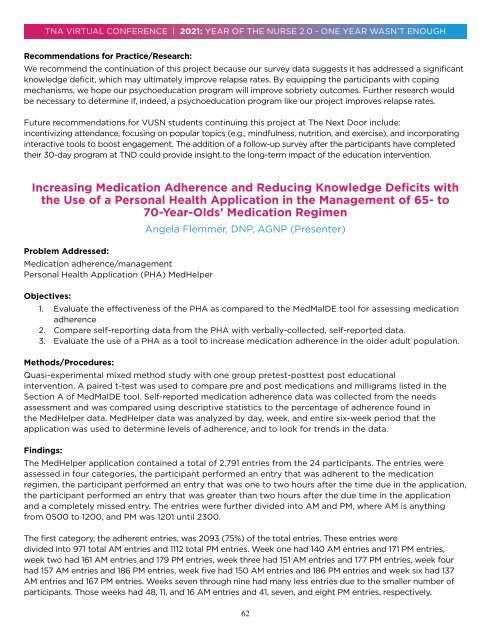2021 TNA Virtual Conference
Create successful ePaper yourself
Turn your PDF publications into a flip-book with our unique Google optimized e-Paper software.
<strong>TNA</strong> VIRTUAL CONFERENCE | <strong>2021</strong>: YEAR OF THE NURSE 2.0 - ONE YEAR WASN’T ENOUGH<br />
Recommendations for Practice/Research:<br />
We recommend the continuation of this project because our survey data suggests it has addressed a significant<br />
knowledge deficit, which may ultimately improve relapse rates. By equipping the participants with coping<br />
mechanisms, we hope our psychoeducation program will improve sobriety outcomes. Further research would<br />
be necessary to determine if, indeed, a psychoeducation program like our project improves relapse rates.<br />
Future recommendations for VUSN students continuing this project at The Next Door include:<br />
incentivizing attendance, focusing on popular topics (e.g., mindfulness, nutrition, and exercise), and incorporating<br />
interactive tools to boost engagement. The addition of a follow-up survey after the participants have completed<br />
their 30-day program at TND could provide insight to the long-term impact of the education intervention.<br />
Increasing Medication Adherence and Reducing Knowledge Deficits with<br />
the Use of a Personal Health Application in the Management of 65- to<br />
70-Year-Olds’ Medication Regimen<br />
Problem Addressed:<br />
Medication adherence/management<br />
Personal Health Application (PHA) MedHelper<br />
Objectives:<br />
Angela Flemmer, DNP, AGNP (Presenter)<br />
1. Evaluate the effectiveness of the PHA as compared to the MedMaIDE tool for assessing medication<br />
adherence<br />
2. Compare self-reporting data from the PHA with verbally-collected, self-reported data.<br />
3. Evaluate the use of a PHA as a tool to increase medication adherence in the older adult population.<br />
Methods/Procedures:<br />
Quasi-experimental mixed method study with one group pretest-posttest post educational<br />
intervention. A paired t-test was used to compare pre and post medications and milligrams listed in the<br />
Section A of MedMaIDE tool. Self-reported medication adherence data was collected from the needs<br />
assessment and was compared using descriptive statistics to the percentage of adherence found in<br />
the MedHelper data. MedHelper data was analyzed by day, week, and entire six-week period that the<br />
application was used to determine levels of adherence, and to look for trends in the data.<br />
Findings:<br />
The MedHelper application contained a total of 2,791 entries from the 24 participants. The entries were<br />
assessed in four categories, the participant performed an entry that was adherent to the medication<br />
regimen, the participant performed an entry that was one to two hours after the time due in the application,<br />
the participant performed an entry that was greater than two hours after the due time in the application<br />
and a completely missed entry. The entries were further divided into AM and PM, where AM is anything<br />
from 0500 to 1200, and PM was 1201 until 2300.<br />
The first category, the adherent entries, was 2093 (75%) of the total entries. These entries were<br />
divided into 971 total AM entries and 1112 total PM entries. Week one had 140 AM entries and 171 PM entries,<br />
week two had 161 AM entries and 179 PM entries, week three had 151 AM entries and 177 PM entries, week four<br />
had 157 AM entries and 186 PM entries, week five had 150 AM entries and 186 PM entries and week six had 137<br />
AM entries and 167 PM entries. Weeks seven through nine had many less entries due to the smaller number of<br />
participants. Those weeks had 48, 11, and 16 AM entries and 41, seven, and eight PM entries, respectively.<br />
62

















